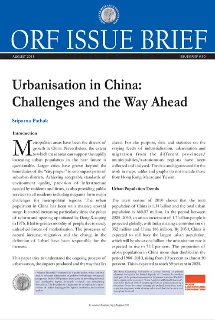Metropolitan areas have been the drivers of growth in China. Nevertheless, the extent Mto which these areas can support the rapidly increasing urban population in the near future is questionable. Larger cities have grown beyond the boundaries of the “city proper” to encompass parts of suburban districts. Achieving acceptable standards of environment quality, provision of infrastructure needed by residents and firms, as also providing public services to all residents including migrants form major challenges for metropolitan regions.
The urban population in China has been on a massive upward surge. It started increasing particularly since the policy of reform and opening up initiated by Deng Xiaoping in 1976. It led to greater mobility of people due to newly unleashed forces of marketisation. The processes of natural increase, migration and the change in the definition of ‘urban’ have been responsible for the increase.
The latest census of 2010 shows that the total population of China is 1.34 billion and the total urban population is 665.57 million. In the period between 2025- 2050, an urban increment of 1.7 billion people is projected globally, with China making a contribution of 186 million. By 2050, China is expected to still have the largest urban population, which will be about one billion; the urbanisation rate is expected to rise to 73.2 per cent. The proportion of urban population in China more than doubled in the period 1980- 2010, rising from 19 per cent to almost 50 per cent. This is expected to reach 59 per cent in 2025.
This paper tries to understand the ongoing process of urbanisation, the impacts produced and the way that lies ahead. For the purpose, data and statistics on the varying levels of industrialisation, urbanisation and migration from the different provinces/municipalities/autonomous regions have been collected and analysed. The data and figures used for the work in maps, tables and graphs do not include those from Hong Kong, Macao and Taiwan.
The views expressed above belong to the author(s). ORF research and analyses now available on Telegram! Click here to access our curated content — blogs, longforms and interviews.

 PDF Download
PDF Download



 PREV
PREV


